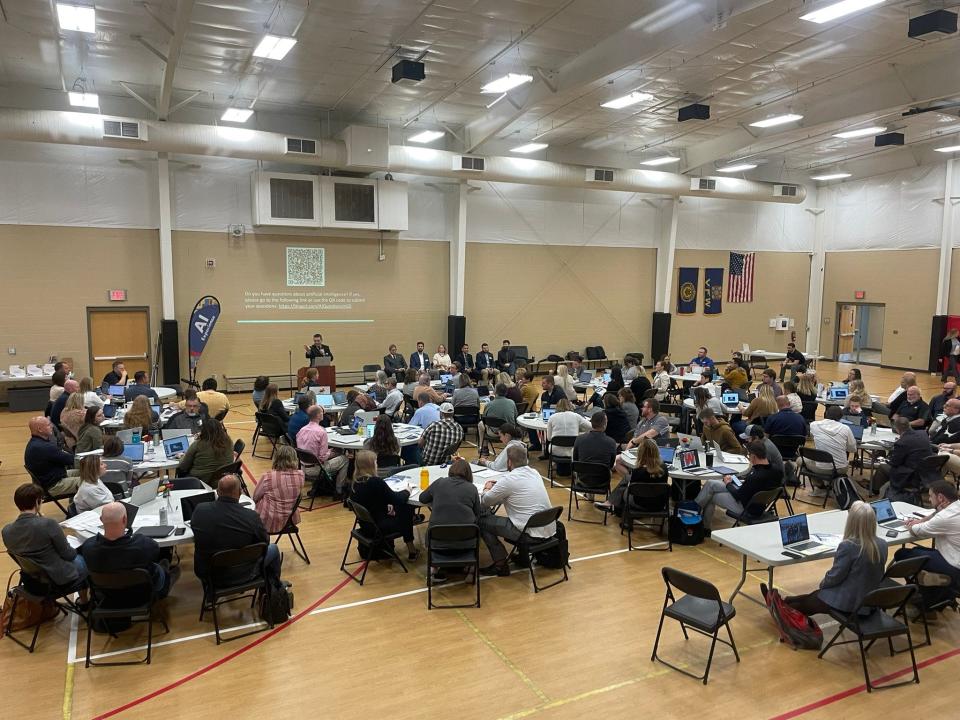Artificial intelligence trainings help teachers learn how to use AI in the classroom
Artificial intelligence (AI) does have a place in education, and teachers, school administrators and school board members learned how they can use AI in school and how it can be beneficial to students in a series of trainings across the state this month.
Over 350 teachers from Rapid City, Aberdeen, Harrisburg and Chamberlain attended the four trainings with educators from University of South Dakota, Dakota State University, School Administrators of South Dakota, Associated School Boards of South Dakota, the South Dakota Department of Education and Technology & Innovation in Education leading the sessions.
As AI has become more prevalent, teachers have shared concerns with Amy Schweinle, dean of the USD’s School of Education, about what AI means for their classroom and how it’s one more thing they have to learn.

Teachers can use AI for administrative tasks that take up a lot of their time, such as writing emails about upcoming school events, scheduling, creating rubrics, or ideas for lesson plans, Schweinle said, but she recommends teachers reread what the AI came up with and edit it as needed.
“Never just take what you get from AI without going through and revising it yourself,” she said. “Put your own take on it, read through it, make it sound like you, make it personal to you.”
AI can save teachers time that they can instead use to work with their students, Schweinle said.
The number one thing teachers use AI for is lesson planning, DSU College of Education Dean David DeJong said. In the trainings, he helped teachers learn how to put their ideas into AI to look for ways to improve them.
“(AI) comes up with some pretty good ideas that can help them immediately with their lesson plan,” DeJong said. “They’re just amazed at how easy that is. It’s been fun to be a leader across the state in elevating the profession and equipping teachers to use AI more.”
It’s important that educators start with their own ideas first, then run them through AI and take a critical look at what AI suggests, DeJong explained. Teachers can then continue on with their own thoughts rather than rely entirely on AI.
“You can get as specific as (asking AI), ‘Give me a hands-on idea for 22 minutes for third graders when I’m introducing the concept of electricity,’ and you can tell AI what materials you have to work with, and it will come up with ideas or questions you can ask the students that may have taken teachers hours to create on their own, but it generates in a matter of seconds,” DeJong said. “It’s just helping them be more efficient.”
Students can also use AI in their education, but must do it ethically and appropriately, Schweinle said. It’s not something elementary school students would be using because it requires some information literacy and critical reading skills, she explained.
Teachers could ask their students to write a paper with AI, but then supplementing every fact in the paper with an original source, Schweinle said. Teachers have also used AI to present pro and con sides to debates that their students can use to rebut against.
“Students, too, need to understand what it is that they’re using,” Schweinle said of AI. “They also need to understand what AI is, how it works, how it was trained, (and) that it’s not giving you accurate, perfect information. They need to understand that sometimes they get wrong information. Sometimes AI makes up references. They need to start thinking about the ethics of (AI).”
Good ethics discussions about AI in modern life — self-driving cars, Siri, Alexa, Google Assistant and personal data and information — can also be had in classrooms, Schweinle explained.
More: Data: SDSU football games have dominated alcohol sales in the last year since policy OK'd
“Kids know about AI. They know it’s there,” Schweinle said. “If we’re not at the forefront of having these conversations with them (about) using AI appropriately, they’re going to be learning about it from their friends, so I think we need to be the ones guiding the conversation. We need to think about how we change our teaching.”
DeJong compared the advent of AI to the introduction of calculators into math classes, which led to a fear kids wouldn’t learn math anymore, and made math teachers rethink how they gave out assignments, having students “double down” on showing their work, he said.
“When we talk about those lessons math teachers learned a long time ago, (for) English teachers, that sparks ideas with them about how they can tweak their assignments that they give to students instead of just assigning an essay that ChatGPT could write in a matter of seconds,” DeJong said.
This article originally appeared on Sioux Falls Argus Leader: South Dakota teachers receive artificial intelligence training

